I’ve been sifting again through my collection of ecclesiastical embroidery photos. There’s a lot to learn from ecclesiastical embroidery – whether you use what you learn for religious or for secular needlework, the lessons can be quite helpful.
In this piece, there are a few notable points that catch my attention and that are worth learning from. Two in particular are “time savers” – time saving being a relative term, of course!
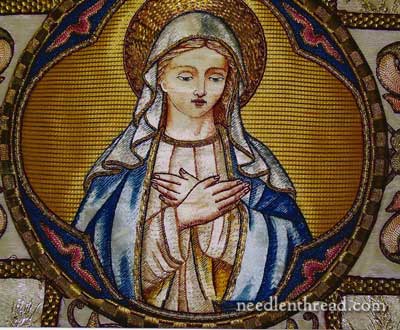
I had to scan a photo to get this image. Scanning a photo brings with it some disadvantages, especially when it comes to zooming in on details! Still, there’s enough here to notice, and considering how long ago the photo was taken, the scan came out pretty well.
First thing to note: the image is not completely embroidered. From far away, you get the sense of an embroidered figure, but in fact, it’s not. This piece is an excellent example of the combination of skilled painting and needlework.
Some ecclesiastical embroiderers from the turn of last century thought that the combination of paint and embroidery “cheapened” needlework. And maybe this is so, to a degree. Compared to the ornate and intricate needlework on ecclesiastical garb from the preceding centuries, using paint in combination with embroidery may have seemed like a “cheap” short cut.
But we have to understand these things in the context of the times. As people became more accustomed to receiving orders for machine-made goods quickly (due primarily to industrialization), the combination of painting and needlework afforded the ecclesiastical embroiderer a way to produce “hand embroidered” goods that were still beautiful, in a more timely manner. Sometimes, the combination of the two mediums produced less-than-satisfactory results, but when the designer, the painter, and the needleworker were all very skilled in what they did, the results were quite beautiful. I think this piece is an example of a good combination of painting and embroidery.
But turn-around times weren’t the only reason that painting and embroidery were combined during the latter 1800’s through the 1900’s. It was also a “style” of the day. During the Arts & Crafts movement, the combination of appliqué and embroidery – especially for figures – was quite common. These pieces of painted & embroidered ecclesiastical works are often also examples of very well-executed appliqué in the style of the day. In the case of this figure, I don’t believe there’s any applique within the figure itself – it looks as if the embroidery were all worked on one piece of painted fabric. The figure, though, is appliquéd to the background (a frequently-used technique in ecclesiastical work).
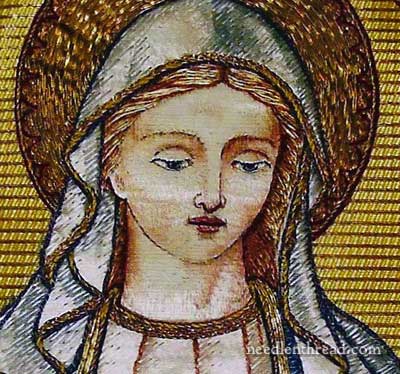
It’s somewhat difficult to discern what was stitched and what wasn’t in the photo of the piece. In fact, there are some areas of disintegration, where stitching obviously was, but is no more. But at the base of the neck, you get a clear idea of how stitches were used. In filled areas, stitching either provides highlight or shadow on this type of piece. Outlines and distinguishing elements (like the lips, the eyes & eyebrows, the hair) would also be stitched.
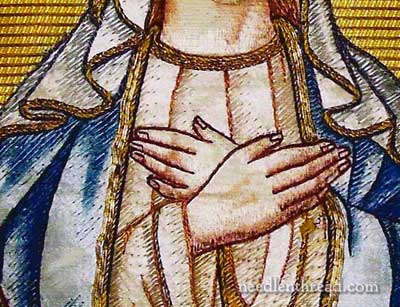
You can see the slashes of stitching that highlight the folds of the robe. You can also see the stitches on the fingers and the base of the top of the hand – though not in the middle of the hand.
The neckline of the gown, the edge of the veil, and the edge of the robe are all lined with goldwork. If this piece had any appliqué to it, these heavy borders worked in gold would serve to cover up the edges of the appliqué.
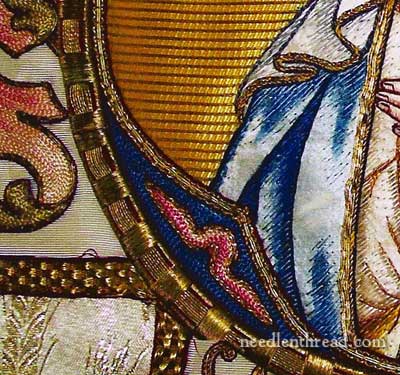
The medallion is outlined in a manner similar to the ecclesiastical embroidery I showed you last week – gold threads worked over card. The interstices on the medallion are filled with blue silk and two shades of pink, worked in chain stitch with a tambour needle. You can see a bit of the design beyond the medallion, in the left side of the photo. Again, this is tambour work in silk, outlined with gold, and then again with a dark fine thread.
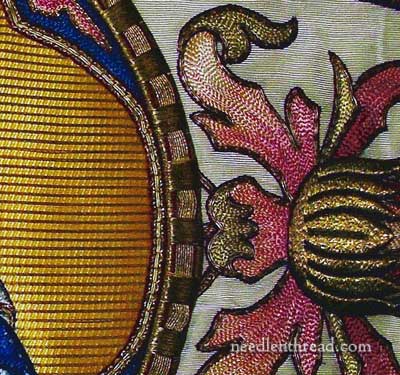
Here, you can see a better shot of what is on the sides – a stylized “pomegranate” design, worked in silk tambour work, with a gold center “fruit” and gold outlining around all the petals.
Tambour embroidery is very commonly seen on vestments from this era (actually, it was popular for a couple hundred years). Tambour work involves embroidering with a special needle affixed to a handle, that is very much like a tiny crochet hook or even a latch hook, without the latch. The tambour needle allows the stitcher to work chain stitch quite rapidly across the surface of the fabric, with one hand underneath the fabric guiding the thread. With its “plunge, wrap, turn” movement between both hands (which takes a bit of coordination to get used to!), tambour embroidery works up faster than surface embroidery done with a regular needle. So while the embroidery here is not machine done, it is certainly done a lot faster than regular surface work, and hence its popularity in the vestment making industry.
So on this piece, we have two techniques that were “time savers”: the combination of paint and stitching, and tambour work. Both approaches require finely-honed skills in order for the work to come off well. Both approaches have their use in secular and ecclesiastical work. But whether or not either approach will actually speed up the process of your creative endeavors – well, I can’t guarantee that… Still, by looking at some of these pieces up close, maybe you’ll find some inspiration for your own needlework!







I always feel disappointed by paint. A lot of “art quilters” are using paint as a predominant element in their art. I am always much much more impressed by someone who can achieve an art look using purely textiles.
Hi, Metanoia – Yes, I know what you mean. I’ve seen examples of the two mediums combined, though, that are really gorgeous…. and some, admittedly, that are rather Otherwise! I think it depends a lot on the design, the designer, and the artists involved in carrying it off. ~MC
Dear Mary
Thanks for this interesting post, I never realised that the technique of painting and needlework were worked together to produce art. I would love to see the technique up close, especially goldwork, painting and the different stitching together, it would be interesting to compare and contrast the different techniques.
Regards Anita
hola mary’creo que para cualquier bordadora el miedo es ‘que se reemplace el bordado por ,la tecnologia o la pintura’ojala no pase nunca,,
si el bordado es bueno y el pintor excelente
,se pueden complementar..y asi obtener un buen trabajo y unico’
en cuanto poder aplicar la tenica ,de puntaslo encuentro muy acertado..
gracias po ayudarnos
lidia de chile
How much does it cost for a Marian embroidered applique?
Hi, Thanks for your question! I don’t sell the Marian Medallion, I’m afraid. It was a one-off custom project.
FYI, if it’s a real photograph as opposed to a printed image from a book … scan at at **least** 300-600 dpi and save as a .TIF file.
If it’s from a book, bu sure and turn “descreen” ON. If you have several different settings, try them all and examine the images at 200% to pick the clearest.
300 dpi gives you size-for-size if you take the image to your photofinisher for a print
I promise you that you can get incredible detail out of those images. You should see some of the things that I’ve scanned out of Schuette!
Email or PM if you want to talk.